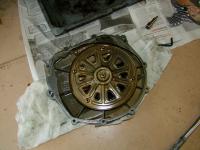...
BTW I've seen a lot of your pics and enhanced or not they are incredibly crisp. How do you do it, or is a trade secret?
Off topic, but then it's your topic, and it's Friday, and we're in NEPRT, so what the heck ...
No trade secrets.
I usually use a reasonable camera, currently a Fujifilm Finepix S100FX. It's a so-called "bridge" camera, between a "point and shoot" and a proper TTL reflex. Takes much better pictures than any phone camera.
Its lens is large by many camera standards, much more important than "number of pixels" (10M), although that helps.
The biggest problem with "taking FJR to bits" photos is the light. In bright sunlight, the contrast is too great. If it's dark, my garage lighting isn't exactly photo-studio standard. Flash often gives nasty reflections, hard shadows, or I can't get the flash into the part I want to photograph. So that needs care. Also, in low light, camera shake is a problem (actually it's mcatrophy-hand-shake). In the limit, I'll use a tripod, but that's rare.
Focusing I generally leave up to the camera in its "Auto" setting, as with most of my exposures. So long as I get it to focus on the bit I want to show, the camera does pretty well.
I originally bought it for its lens, which is a 28 to 400 (35mm equivalent) zoom, to try to get wild-life pictures. Most of these turn out nothing like as good as I'd hoped for, but one example is this:
(click on any image for larger view, click on that for the full picture, but be prepared to wait while it loads
.
Wide-angle view . . . . . . . . . . . . . . full zoom . . . . . . . . . . . . . . . . . . . . cropped centre



[edit] The background can also be very important. In the above pictures, I moved for the second so that the birds and nest had the sky instead of the rocks behind. Don't forget to click on the 3rd thumbnail above to get the full size.[/edit]
The enhancing I do tends to be gamma correction, altering the relative brightness of different brightness levels, typified by the clutch pictures in
my post above, where I've expanded the dark bits and compressed the bright bits.
I usually inspect my pictures as I go to ensure the focus and composition is OK, and if I need to, and the subject is still there, I will re-take. Occasionally I use the camera's multi-picture mode (like a slow, full resolution movie) and choose the best frame from the sequence.
The camera lens does show significant chromatic distortion with some subjects, but that is a compromise I'm content to live with for some of the better shots.
So, there you have it, a reasonable camera, and a bit of care.













